- Editorial Offices
- 325 Brantly Hall
- Missoula, MT 59812
- (406) 243-2488
- themontanan@umontana.edu
- Icons By Maria Maldonado
Montana Osprey Project brings beauty, knowledge, inspiration and a bit of drama to fans worldwide
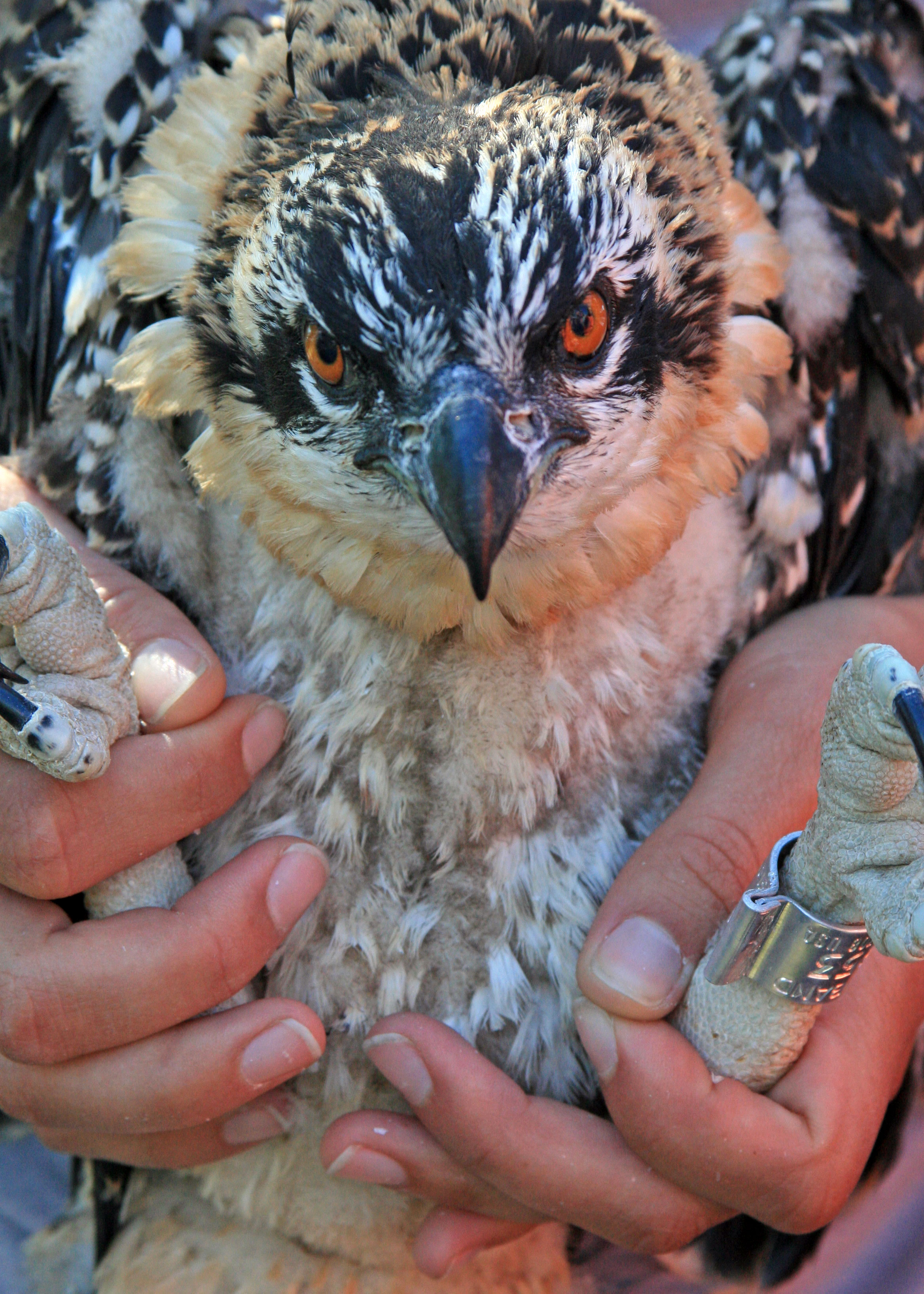
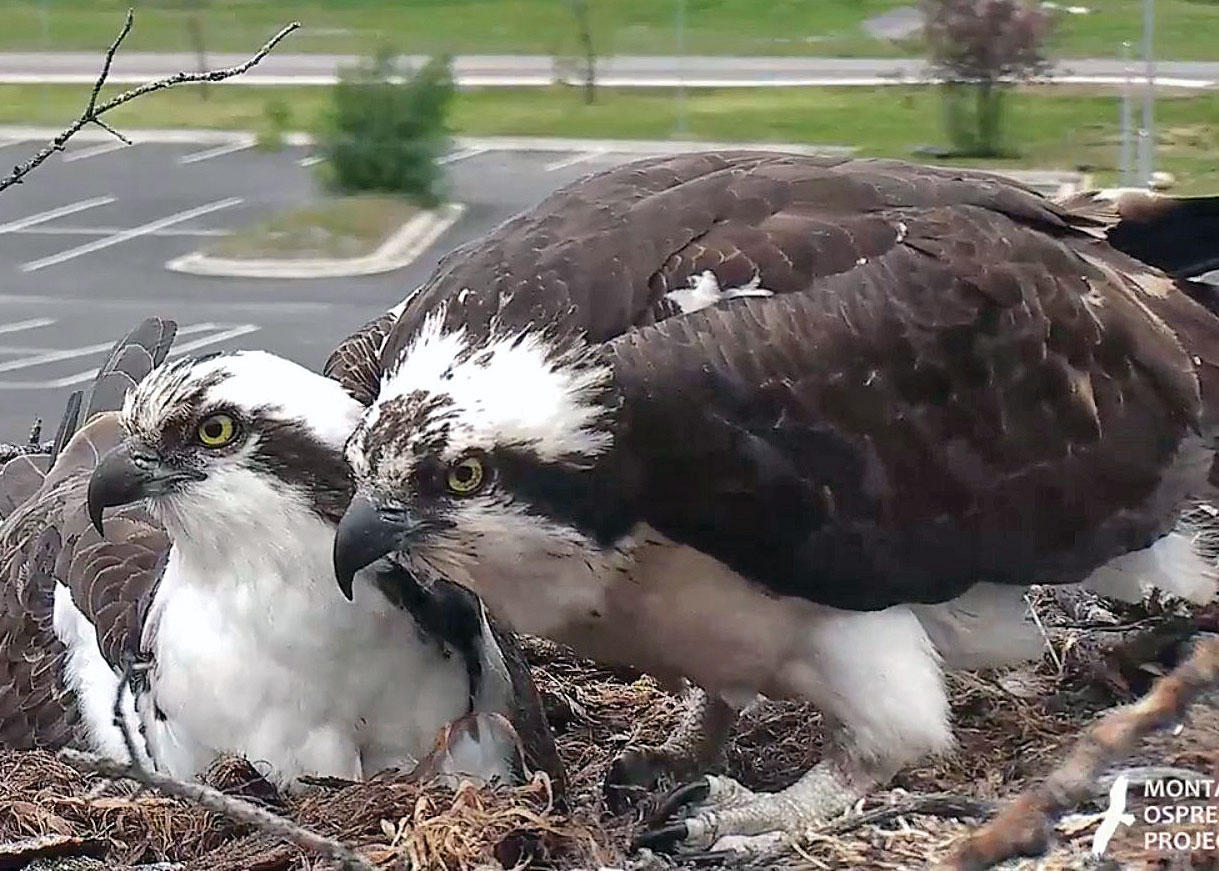
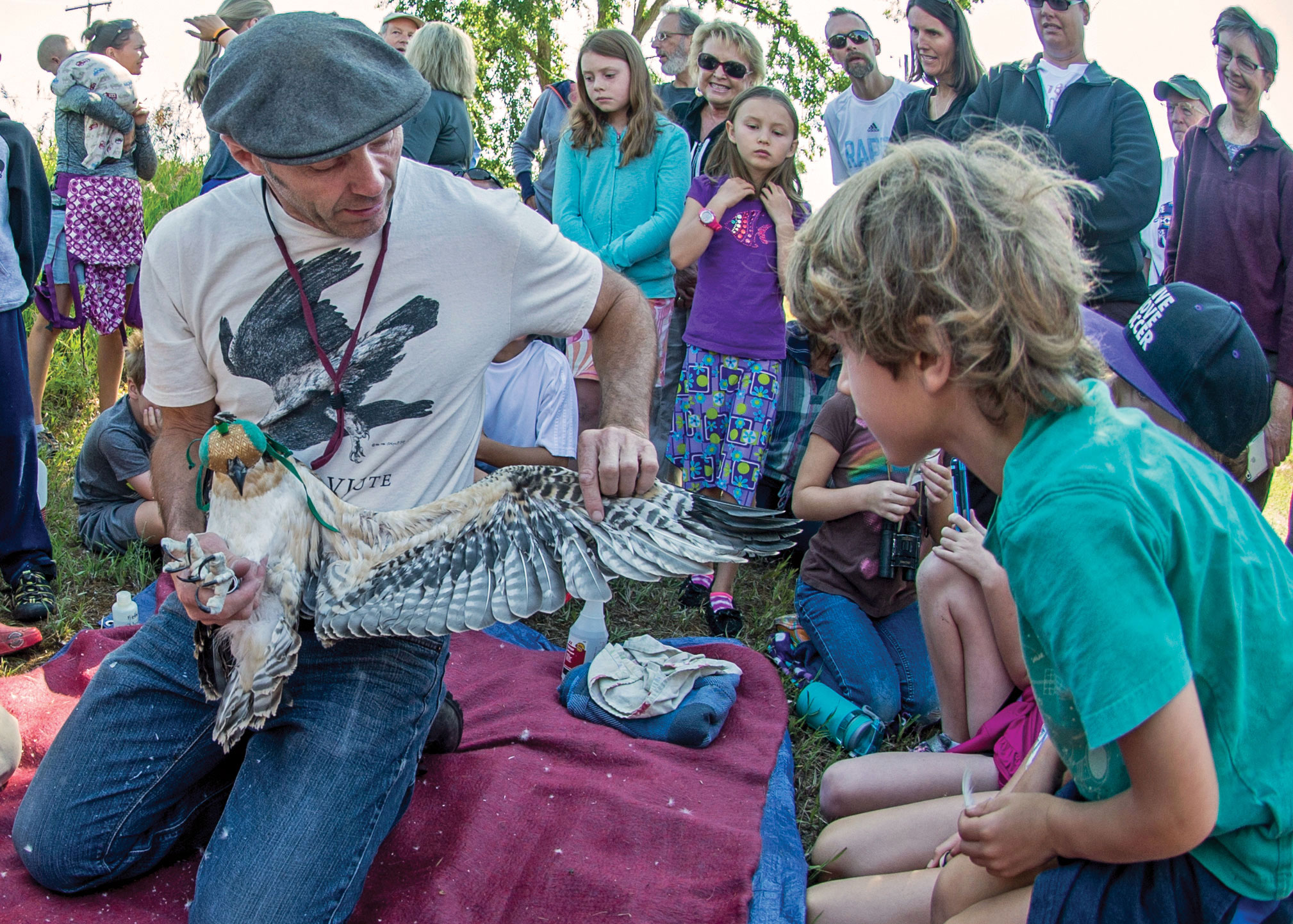
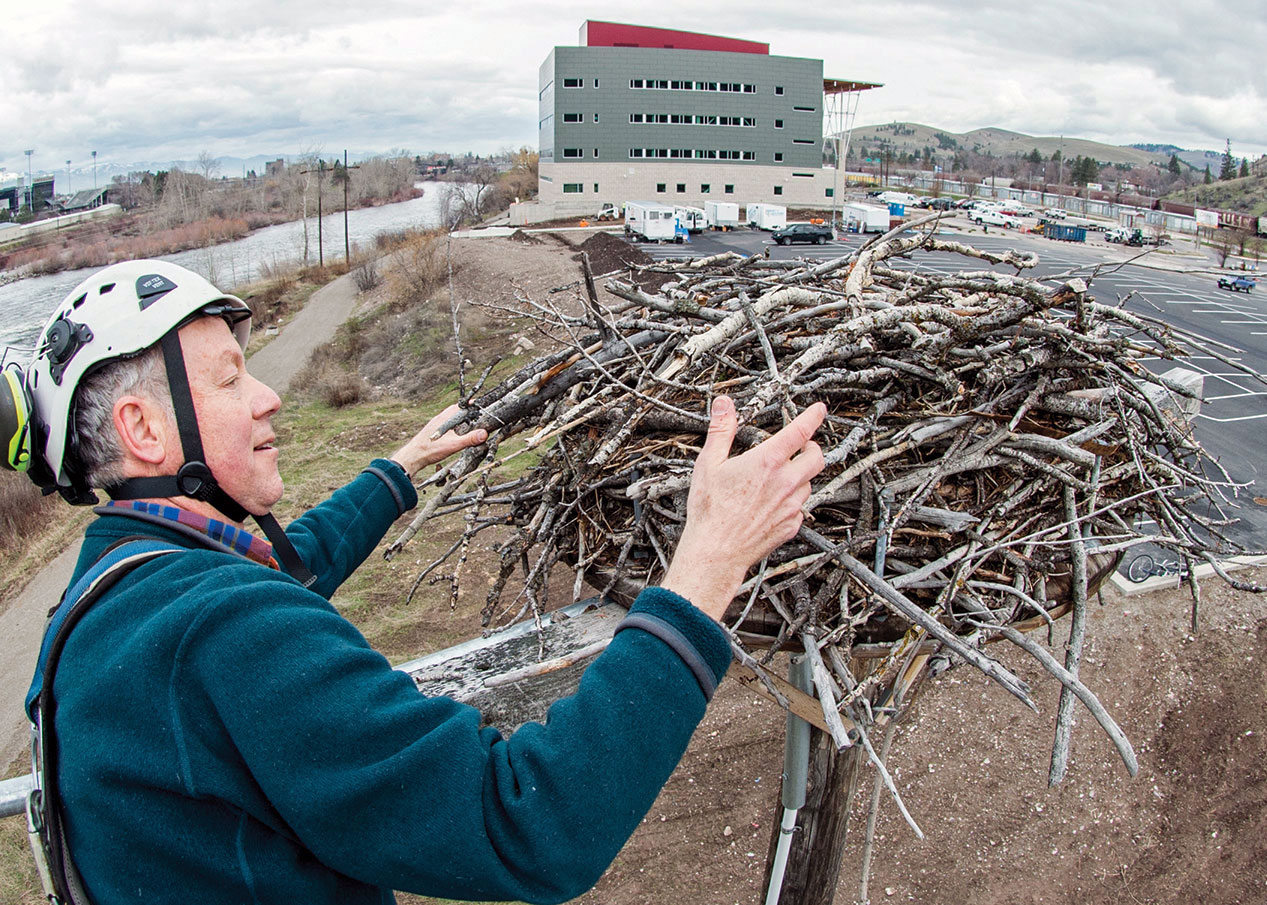
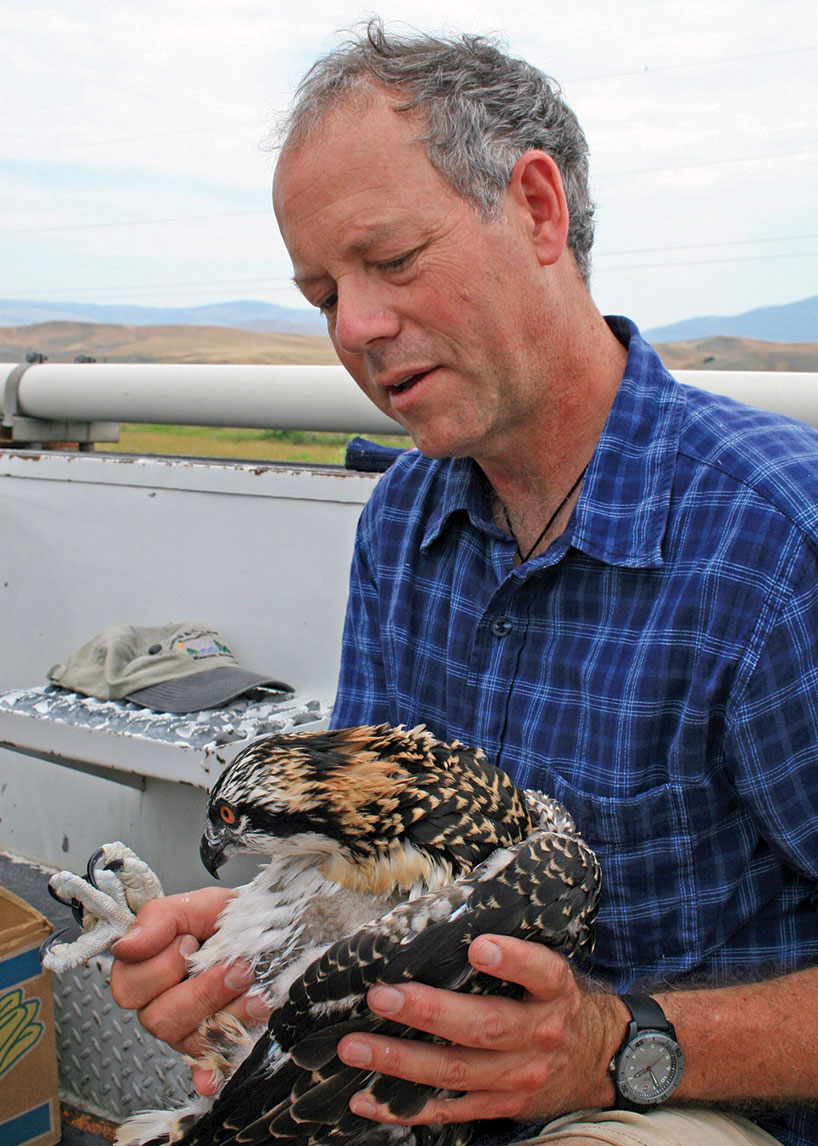

It’s usually the rare bird that wins all the praise, but when it comes to ospreys, being common is one of its most magnificent traits.
Ospreys are tied to fish and clean water, they are incredibly tolerant of human activity, and people love watching them plummet out of the sky to catch fish. For the past decade, the University of Montana-based Montana Osprey Project, which is made up of a team of scientists, educators and students, has used ospreys to learn about the health of our streams, rivers and lakes, as well as bring information about our environment to thousands of people around the world through social media and online bird cams.
Central to the story of the Montana Osprey Project is an osprey named Iris. For more than 10 years, the project has monitored her life as she returns to Montana each spring. Iris is named for the distinctive dots in her iris, which allow her to be identified when she returns every spring with a high-resolution webcam overlooking her nest. Clips on YouTube show Iris raising chicks, eating fish from the waters of the Clark Fork and weathering the harsh wind whipping furiously past her nest at the mouth of the Hellgate Canyon. Sometimes there are small dramas: One clip captures Iris and her mate building their nest, tugging together on a stick as if they were newlyweds disagreeing where the living room couch should go.
“It is a soap opera,” says UM wildlife biologist Erick Greene, with a laugh. “And Iris is a rock star.”
The Montana Osprey Project is a three-pronged project focused on environmental research, education and conservation. The project’s webcam in Hellgate Canyon started out as another way for researchers to monitor the birds, and soon thousands of people in more than 200 countries were riveted by the ospreys.
“It’s become part of the education we do,” Greene says. “And it’s taken on a life of its own.”
The project began as a long-term study of osprey ecology and heavy metal contamination in Montana’s upper Clark Fork River and its tributaries. A century of copper mining in Butte and Anaconda led to heavy metals – arsenic, cadmium, zinc, lead and copper – settling behind Milltown Dam near Missoula. In 2005, when the decision was made to remove the dam and restore the watershed, raptor expert Robert Domenech realized there was an opportunity to track the results of the cleanup with the help of ospreys.
Ospreys sit at the top of the aquatic food chain, so heavy metals in sediments magnify by about 10,000-fold by the time they reach the bird’s system.
“Ospreys are the canaries in the coal mine when it comes to the health of that ecosystem,” Domenech says.
Domenech was already neck-deep in migratory golden eagle research at the Raptor View Research Institute, which he started in 2004. Nevertheless, in 2006, he began work on an osprey project with Heiko Langner, then-director of UM’s Environmental Biogeochemistry Lab. Of particular importance to the project was Domenech’s uncle, Dave Taylor, who owned a boom truck as part of his roofing company. Taylor would drive Domenech everywhere, from Warm Springs to St. Regis, using the truck to lift him up to the nests. He’d capture the osprey chicks, take blood samples and measure toxic substances in the lab.
Two years into the project, Domenech brought Greene on board and the project continued to snowball. In 2012, they published a paper on an unexpected element they were finding in the birds’ systems: mercury. Mercury has long been used in gold and silver mining, especially in Flint Creek near Philipsburg. And though it’s much more regulated today, highly toxic remnants are still in the ecosystem.
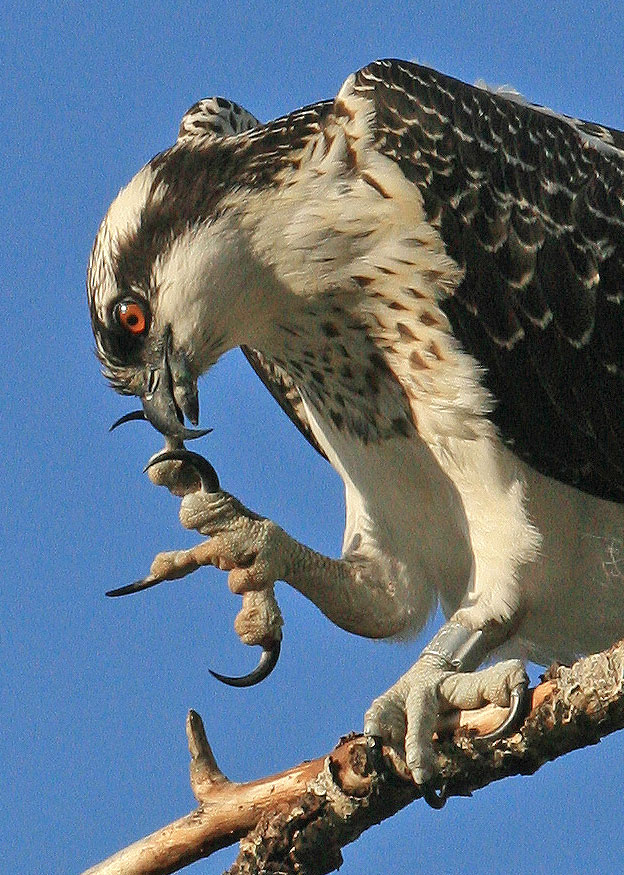
The researchers also noticed other important environmental issues that could be solved with just a little community effort. Baling twine, for instance, is a favorite material on osprey nests, but the birds get tangled up in it and many die.
“We could have a positive impact regionally by just cleaning up baling twine on our land,” Domenech says, “and then we wouldn’t have birds swinging from their nests. What’s going on with raptors is a reflection of what’s happening with the ecosystem as a whole.”
Ospreys are found on every continent except Antarctica. And in many places in western Montana, Greene says, you’re almost guaranteed to be just a few miles from an osprey nest at any given time. That makes them the perfect ambassadors for education.
“They are the most tolerant raptor of any raptor species,” Greene says. “Just add water and you’ve got osprey.”
Over the past 10 years, the Montana Osprey Project has taken tens of thousands of people out to see osprey nests as part of its educational mission. Another educational effort is Wings Over Water, which is funded through the Montana NASA Space Grant Consortium and managed by researcher and educator Jenelle Dowling at the Montana Natural History Center. It involves bringing scientists into the classrooms and working with teachers to create STEM (science, technology, engineering and mathematics) lessons based around the topic of ospreys.
In June, five middle school teachers were invited to UM for an intensive five-day training workshop where they learned about osprey biology, the physics of flight, GPS technology and the Environmental Biogeochemistry Lab. As experts in their own field, the teachers thought about how to apply what they learned.
“Every day we worked on the curriculum,” Dowling says. “And the teachers figured out how to present these lessons in classrooms, but they also worked with experts to get an idea of how they can incorporate this research into their lessons.”
A few weeks ago, after taking the workshop, Seeley Lake teacher Patti Bartlett spotted a new osprey nest on the top of a utility pole in town.
“I called the power company and they said they’d have to tear the nest down,” she says. “And I thought, ‘What a perfect opportunity.’”
Bartlett plans to work with the Montana Osprey Project and the Missoula Electric Co-op to have her students build a platform so the nest can be moved from the dangerous spot on the power lines and closer to their classroom.
“I can hardly wait,” Bartlett excitedly says. “You couldn’t ask for a more perfect learning opportunity for the kids. When kids invest in the place they live, then they become better stewards of the land. And that’s my goal.”
In 2011, Greene and his colleagues set up a camera at the Hellgate Canyon nest. They wired it through Riverside Health Care Center, whose elderly clients enjoyed watching the osprey from their window and a live feed in the lobby. Iris and her mate, Stanley, had a successful brood of chicks that year, and everything was looking good for them.
A couple of years after launching the camera, Greene started getting checks in the mail that added up to thousands of dollars. Each check was made out to the osprey project in honor of a woman named Peggy Taylor-Miles, who Greene didn’t know. He discovered she was a bird lover from Oregon who had been diagnosed with ovarian cancer in 2012. During her long hours of treatment, she became a huge fan of the Hellgate osprey cam. When she died in 2013, Taylor-Miles’ family asked people to remember her by donating to the Montana Osprey Project.
“When I started getting all this money, I phoned her husband,” Greene says. “I said, ‘We don’t have a way to support student researchers working on the project. Would you mind if we make a special account in Peggy’s name to support students?’ He said, ‘Let me think about it … Yes!’”
Taylor-Miles never got to visit Missoula, but her family came out to the osprey nest after her death to accept a plaque dedicated to her. Later that year, when Iris and Stanley hatched two chicks, they were named Taylor and Miles in her honor.
The past three years have been tough on Iris. She and her mate, Stanley, lost their eggs to a hailstorm in 2015. The next year, Stanley didn’t return to the nest, which created some sadness in the osprey cam community. Ospreys mate for life, which means he probably didn’t survive. Iris ended up pairing with a new mate, Louis. Most recently, Louis and Iris lost their chicks this past spring after difficult fishing conditions led to their starvation. It was hard on everyone, but Greene used the opportunity to talk with osprey fans about the challenges wildlife face.
The 2014 announcement that the new Missoula College Building would be constructed along the river off East Broadway was exciting for a lot of people, but for Greene it was cause for concern. Designs for the building showed it would butt up against the osprey nest. Greene immediately called then-UM President Royce Engstrom and insisted they go to lunch.
“I bought him a sandwich and a coffee and took him over to the site,” Greene says. “I said, ‘Congratulations. You’re going to build a building here, so you have to know about this osprey nest.’”
He told Engstrom about the osprey cam and its millions of fans. He talked about the two UM Foundation accounts where people from all over the world donate money to the project. He told him about the students who come to UM each year to participate in osprey research. That same day, Engstrom made an executive decision: Missoula College would be built on the other side of the lot, giving the osprey nest wider berth.
That was a big win for the project, but there were still challenges ahead. The building of the college itself had the potential to disrupt Iris and Stanley’s lives and drive them away, so the project required a company that would be sensitive to the birds. UM chose Jackson Contracting for the job. Builders aren’t used to considering birds – they have important timelines to meet – but eventually they were fully on board.
“On top of their timeline, in their construction war room, they had written Iris and Louis’s timetable, too: when they would return to the nest, their courtship and egg-laying times,” Greene says. “And they built their construction timeline around the birds so they wouldn’t be disturbed. And so, even though there was an empty osprey nest 200 yards away that they could have gone to during the construction, they didn’t abandon this nest. They stayed. And that is really special.”
As the building neared completion, Greene approached Missoula College Dean Shannon O’Brien. He knew it was important that the college, now also overlooking the nest, be invested in the osprey. He also had ideas for how the college could integrate the osprey into their studies.
Fortunately, O’Brien is an osprey fan and a proponent of progressive education. She recalls living near an osprey nest when she was a child and learning from her dad about them. That curiosity, she says, is part of the reason she was already eager to meet with Greene. She gave him a small office on the third floor of the building, where he could observe the nest.
The conversations about how Missoula College might incorporate osprey research have been fruitful. The nursing program is interested in the way osprey could help students understand the human health impacts of mercury. And Greene is hoping to get welding and micro-electronic students to help build osprey perches fitted with digital scales for weighing the birds and the fish the birds bring back to the nest. In addition, computer technology and marketing classes could work on projects involving the webcam.
“That camera creates worldwide awareness of Missoula and Missoula College,” O’Brien says. “But it also helps our students and faculty think of the world around them. We need connectedness in our society. And this is a phenomenal way to be connected.”
Greene also collaborated with the Cornell Lab of Ornithology in Ithaca, New York, to upgrade to a high-definition fiber-optic camera, which they now run through the computer system at Missoula College. The lab’s bird-cam project leader, Charles Eldermire, a UM graduate, flew to Missoula to help set it up.
“Erick is a great spokesperson and really an empathetic person to the community,” Eldermire says. “The combination of his ability to talk about the science but also to connect with people has made it a really impactful camera.”
Recently, a new coffee-table book about the project, called “The Call of the Osprey” by Dorothy Hinshaw Patent and photographer Bill Mu~noz, won a prestigious award for the best STEM book for middle school and high school kids in the world. These kinds of successes prove something Greene is certain of: Osprey inspire people. He hopes one day that the curriculum and research the Montana Osprey Project develops will make its way to places around the world for everyone to engage with.
After all, there’s plenty of osprey to go around.
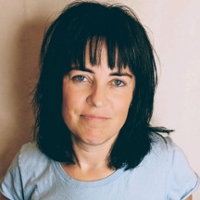
Erika Fredrickson is a freelance journalist based in Missoula. She graduated from UM’s Creative Writing Program in 1999 and earned a master’s degree in environmental studies in 2009.